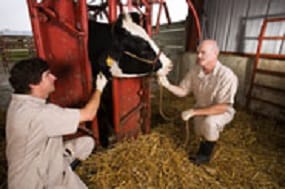Veterinary Safety & Health: Physical Safety
Physical Safety

Photo credit: USDA Agricultural Research Service/Peggy Greb
Animal handling and restraint hazards
- Improved livestock handling facility design and restraining facilities can decrease injuries in animals and workers.
- Most bite, scratch, kick, and crush injuries from animals can be prevented by using appropriate restraint and following established procedures.
- Significant injuries and medical emergencies may result if proper procedures are not followed or precautions are not taken.
- Bite and scratch wounds should receive immediate medical evaluation and care due to risks of infection and rabies exposure.
AVMA, Journal of the AVMA: Zoonosis Update: Animal Bites
Humane Society Veterinary Medical Association: Animal Handling and Restraint
Auburn University Livestock Safety Resources
National Agriculture Safety Database Resources
Temple Grandin Livestock Behavior, Design of Facilities, and Humane Slaughter
Ergonomic and musculoskeletal hazards
- Strains, sprains, back injuries and other repetitive motion injuries may occur when lifting, restraining, and treating animals
- Extensive computer use may have ergonomic risks
AVMA Ergonomics Guidelines for Veterinary Practices
NIOSH Ergonomics and Musculoskeletal Disorders
OSHA Ergonomics for the Prevention of Musculoskeletal Disorders in Laboratories
Eye hazards
Eye safety concerns include:
- Penetration wounds from animals, tools, and equipment
- Contamination with dust or other airborne contaminants
Heat stress
OSHA Occupational Heat Exposure
Ionizing radiation
Risk of exposure during radiography increases with the:
- physical restraint of animals
- use of older or poorly maintained equipment
- inadequate use of protective garments
NIOSH Reproductive Health – Ionizing Radiation
Laser hazards
OSHA Laser/Electrosurgery Plume
OSHA/Laser Institute of America Alliance Resources
Motor vehicle hazards
Commuting between farms, facilities, and/or patients increases the risk of motor vehicle accidents.
NIOSH Motor vehicle safety at work
Needlestick, scalpel and other sharps hazards
- AVMA recommends voluntary compliance with the OSHA bloodborne diseases standard (see NASPHV Veterinary Standard Precautions Compendium)
- Sharps injuries may result in lacerations or other traumatic injuries
- Injury from contaminated sharps may result in illness or death (see biological and chemical hazards)
CDC Sharps Safety for Healthcare Settings
OSHA Bloodborne Pathogens and Needlestick Prevention
Noise
Sources of noise above recommended levels in veterinary workplaces may include:
- Barking dogs in kennels and other confined spaces
- Swine when being handled
- Loud machinery and equipment
NIOSH Noise and Hearing Loss Prevention
OSHA Occupational Noise Exposure
OSHA Laboratory Safety – Noise
NIOSH HHE report: HETA-2004-0046-2950, Kirkwood Community College, Cedar Rapids, Iowa [PDF – 1.2 MB]
Outdoor physical hazards
Respiratory hazards
- Many types of organic and inorganic dust and other airborne contaminants are present in confined animals feeding operations and other animal facilities.
- Dust is generated from feed, bedding, manure, and many other sources.
- Dust can be an irritant or an allergen.
- Chloramine compounds generated in settings such as poultry plants from interactions between chlorinated water and nitrogenous materials are respiratory irritants.
- Cleaners and disinfectants similar to those used in veterinary settings have been associated with asthma in a variety of settings, including human healthcare (see Chemical Safety section).
NIOSH Request for Assistance in Preventing Organic Toxic Dust Syndrome
DHHS (NIOSH) Publication No. 94-102 (1994)
North Carolina Swine Veterinary Group: Occupational Hazards on Swine Farms
King BS, Page EH, Mueller CA, Dollberg DD, Gomez KE, Warren AM [2006]. Eye and respiratory symptoms in poultry processing workers exposed to chlorine by-products
Am J Ind Med 49(2):119-26
Arif AA, Delclos GL [2012]. Association between cleaning-related chemicals and work-related asthma and asthma symptoms among healthcare professionals
Occup Environ Med 69(1):35-40
Slips, trips, and falls
Farms, animal facilities, and veterinary facilities may have slippery or uneven surfaces which put workers at risk of injury from slipping, tripping, or falling.
NIOSH Slip, Trip, and Fall Prevention for Healthcare Workers
DHHS (NIOSH) Publication No. 2011-123 (2010)
OSHA Healthcare Slips, Trips, and Falls
Canadian Centre for Occupational Health and Safety Prevention of Slips, Trips, and Falls
Waste disposal
AVMA Waste Disposal by Veterinary Practices: What Goes Where?
National Center for Manufacturing Sciences Veterinary Compliance Assistance
